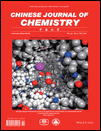Journal list menu
Export Citations
Download PDFs
Cover Picture
Cover Picture: Nitrogen-Doped Nanoporous Carbons through Direct Carbonization of a Metal-Biomolecule Framework for Supercapacitor (Chin. J. Chem. 2/2016)
- Page: 133
- First Published: 19 February 2016

The cover picture is composed by an assumptive structure model of nitrogen-doped porous carbons synthesized by direct carbonization of a nitrogen-rich zinc glutamate metal- biomolecule framework. The background is made from an experimental transmission electron microscopy image. This cover picture illustrates that gas molecules and metal components released by the help of heating and chemical treatments, forming nitrogen-doped porous carbons. These carbons exhibited high specific surface areas (up to 1619.2 m2/g) and also a large specific capacitance of 140.8 F/g at a current density of 0.25 A/g. More details are discussed in the article by Qiu et al. on page 203–209.
Editorial
Special Issue of "Metal-Organic Frameworks"
- Page: 135
- First Published: 19 February 2016
Contents
Reviews
Research Progress of Metal-Organic Frameworks Based on Aromatic Polycarboxylic Acid
- Pages: 143-156
- First Published: 15 December 2015

Metal-organic frameworks (MOFs) synthesized based on aromatic polycarboxylic ligand with metal cations of M (M=Mn, Co, Cd, Cu, Zn, ···) have been reported. The synthetic methods, structures and potential applications of the MOFs have also been introduced in details. The potential applications were chiefly recommended in magnetism, gas adsorption, gas separation, photodegradation, catalysis and emission.
Metal-Organic Frameworks Derived Porous Carbons: Syntheses, Porosity and Gas Sorption Properties
- Pages: 157-174
- First Published: 08 January 2016

Porous carbon materials derived from metal-organic frameworks (MOFs) have been brought into stage due to the intrinsic advantages of MOFs such as high porosity and tailorable structure diversity, which might provide infinite possibility in producing porous carbons with diverse structures and various decorations. In this review, we summarize the performances of MOF-derived carbon materials (i.e. non-doped porous carbons, heteroatoms doped porous carbons, metal/metal oxide decorated porous carbons) and give a detailed discussion about the connections between the properties and four major effects (calcination temperature, loading of additional precursor, post-synthetic treatment as well as intrinsic properties of MOFs).
Water Purification: Adsorption over Metal-Organic Frameworks
- Pages: 175-185
- First Published: 03 February 2016

Metal-Organic Frameworks (MOFs) are promising adsorbents for their numerous active sites, uniform porosity and tailorable structure diversity. And adsorption over MOFs for water purification is an interesting and practical issue considering the importance of qualified water. In this review, we will systematically present the performances of MOFs for inorganic and organic contaminants purification in aqueous phase and give a detailed discussion about their performances, influences and potential mechanisms. We hope it is beneficial to the syntheses, regeneration and reuse of MOF adsorbents and could promote the development of MOFs for water purification.
Postsynthetic Modification of Metal-Organic Frameworks through Click Chemistry
- Pages: 186-190
- First Published: 13 November 2015
Communication
Metal-Anion Coordination and Linker-Anion Hydrogen Bonding in the Construction of Metal-Organic Frameworks from Bipyrazole
- Pages: 191-195
- First Published: 15 December 2015
Full Papers
Three-Dimensional Porous Heterometallic-Organic Frameworks: Synthesis, Luminescent, Magnetic, Adsorption and Hydrogen Storage Properties
- Pages: 196-202
- First Published: 13 November 2015
Nitrogen-Doped Nanoporous Carbons through Direct Carbonization of a Metal-Biomolecule Framework for Supercapacitor
- Pages: 203-209
- First Published: 03 February 2016

Nitrogen-doped nanoporous carbons have been successfully synthesized by direct carbonization of a nitrogen-rich metal-biomolecule framework, and these carbons exhibited high specific surface areas and large specific capacitances, which will further facilitate the exploration of such materials as supercapacitors.
Synthesis and Characterization of Two Isostructural Lanthanide-Containing Metal-Organic Frameworks Constructed from an Unprecedented [Ln7(μ3-OH)8]13+ Cluster
- Pages: 210-214
- First Published: 28 October 2015
![Synthesis and Characterization of Two Isostructural Lanthanide-Containing Metal-Organic Frameworks Constructed from an Unprecedented [Ln7(μ3-OH)8]13+ Cluster](/cms/asset/7ffb96d7-06d9-4c70-bc69-cf17cffcb341/mcontent.jpg)
Two isostructural 3D lanthanide-containing MOFs constructed from an unprecedented [Ln7(μ3-OH)8]13+ (Ln=Gd, Tb) cluster in which the Ln3+ ions are arranged in a distorted vertexsharing dicubane-like geometry were obtained based on a rigid tripodal ligand. Furthermore, the magnetic property of 1 and the fluorescent property of 2 were also studied.
A Hierarchically Porous Metal-Organic Framework from Semirigid Ligand for Gas Adsorption
- Pages: 215-219
- First Published: 13 November 2015
Directional Functionalization of MOF-74 Analogs via Ligand Pre-installation
- Pages: 220-224
- First Published: 28 October 2015

An effective functionalization strategy has been developed. Well designed pre-installation of the ligand can easily remain the original MOF stucture under mild conditions. Meanwhile, the insert of active group into MOF can't be achieved by the multi-constituents assembly method rather than the direct way.
Three New Complexes Based on the Flexible Zwitterionic Dicarboxylate Ligand: Synthesis, Structures, and Properties
- Pages: 225-232
- First Published: 15 December 2015

1 crystallizes in monoclinic space group C2/m, displaying a 2-D layer structure with three unique Cd2+ centers, which are distributed in two mutually-perpendicular planes. 2 and 3 are isomorphic structures with the orthorhombic Cmca space group. They exhibit a 1-D zigzag chain, which can be linked to generate a 2-D layer via the hydrogen bonding interactions (CH···O).
Mn-Based Two Dimensional Metal-Organic Framework Material from Benzimidazole-5,6-dicarboxylic Acid
- Pages: 233-238
- First Published: 08 January 2016
Structures and Properties of Two New Three-Dimensional Inorganic-Organic Hybrid Compounds Based on Isopolymolybdate Clusters
- Pages: 239-245
- First Published: 15 December 2015

Compound 1 features the 3D pillar-layered framework structures assembled by 2D cerium-organic coordination sheets pillared by β-[Mo8O26]4− clusters. Compound 2 exhibits a 3D supramolecular structure containing [Mo6O20]4− polyoxoanions-based 1D molybdate chains through hydrogen bond interactions. The UV-vis spectra and fluorescence properties of compounds 1–2 have also been investigated in detail.














